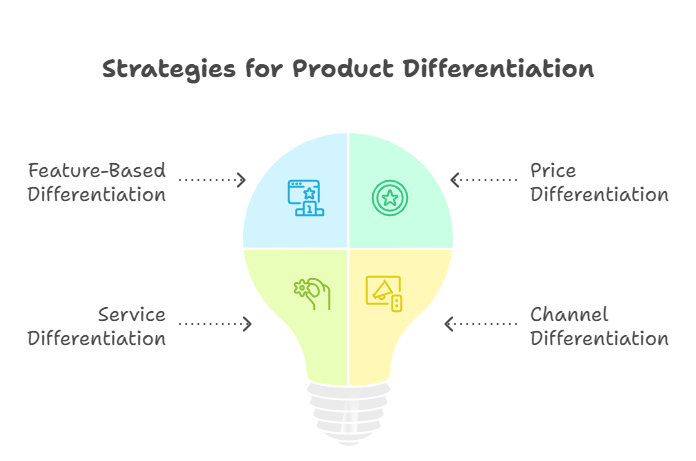What is Product Differentiation? Definition and Examples
Learn what product differentiation is, why it matters for business growth, and how to implement effective differentiation strategies with practical examples.
What is Product Differentiation?
Product differentiation is the process of distinguishing a product or service from similar offerings in the market. Companies use this strategy to highlight unique attributes that set their products apart from competitors, making them more appealing to specific customer segments.
At its core, product differentiation involves discovering the characteristics of your product that your customers value and are unique to you. These distinguishing features become the foundation for your marketing efforts and competitive positioning.
Why Product Differentiation Matters
Effective product differentiation creates competitive advantage by making your offering stand out in crowded markets. When customers perceive your product as unique and valuable, they're more likely to choose it over alternatives, even at higher price points.
Differentiation drives business growth by helping companies capture market share, build brand loyalty, and justify premium pricing. It transforms generic products into must-have solutions that resonate with specific customer needs.
Types of Product Differentiation
Vertical Differentiation
Vertical differentiation focuses on objective quality differences that most customers would agree make one product superior to another. This includes:
- Higher quality materials or components
- Better performance specifications
- Enhanced durability or longevity
- Superior technical capabilities
Horizontal Differentiation
Horizontal differentiation addresses subjective preferences where neither product is objectively better, but appeals to different tastes. Examples include:
- Design aesthetics and styling
- Color options and customization
- Brand personality and messaging
- User experience and interface design
Mixed Differentiation
Most successful products combine both vertical and horizontal differentiation elements to create comprehensive competitive advantages that appeal to multiple customer segments simultaneously.
Key Differentiation Strategies

Feature-Based Differentiation
This approach focuses on highlighting unique features that competitors don't offer. The key is identifying features that your target customers genuinely value and are willing to pay for.
Price Differentiation
Companies can differentiate through pricing strategies, positioning themselves as premium, value, or budget options. Each pricing tier communicates different value propositions to distinct customer segments.
Service Differentiation
Exceptional customer service, support, and post-purchase experiences can become powerful differentiators, especially in markets where product features are similar.
Channel Differentiation
How and where customers access your product can differentiate your offering. This includes exclusive distribution partnerships, unique retail experiences, or innovative delivery methods.
Real-World Differentiation Examples
Apple's Ecosystem Integration
Apple differentiates through seamless integration across its product ecosystem. The ability for devices to work together effortlessly creates a unique value proposition that keeps customers within the Apple ecosystem.
Tesla's Technology Leadership
Tesla differentiated itself through electric vehicle technology when competitors were focused on traditional combustion engines. Their continuous innovation in battery technology and autonomous driving features maintains their differentiation advantage.
Dollar Shave Club's Business Model
Dollar Shave Club disrupted the razor market through subscription-based pricing and direct-to-consumer distribution, differentiating from traditional retail models dominated by established brands.
Implementing Product Differentiation
Understand Your Customers
Start by identifying what your target customers truly value. Conduct market research, analyze customer feedback, and monitor competitor offerings to uncover unmet needs and preferences.
Analyze Your Competitors
Map your competitors' strengths and weaknesses to identify gaps in the market. Look for areas where you can deliver superior value that competitors are overlooking.
Leverage Your Unique Capabilities
Focus on differentiation strategies that align with your company's core competencies and strengths. Sustainable differentiation builds on what you do best.
Communicate Your Differentiation
Once you've identified your unique value proposition, ensure it's clearly communicated through all marketing channels, product messaging, and customer touchpoints.
Common Differentiation Mistakes
Differentiation Without Value
Creating differences that customers don't care about wastes resources and confuses your market positioning. Always tie differentiation to genuine customer benefits.
Over-Differentiation
Adding too many unique features can complicate the user experience and increase costs without proportional value. Focus on meaningful differentiation that enhances the core value proposition.
Under-Communicating Differentiation
If customers don't understand your unique advantages, they can't appreciate them. Ensure your differentiation is clearly articulated and consistently reinforced.
Measuring Differentiation Success
Track key metrics to evaluate your differentiation strategy:
- Market share growth within target segments
- Price premium acceptance
- Customer retention and loyalty rates
- Brand awareness and perception
- Competitive win rates
Tools for Product Differentiation Planning
Visual thinking tools like ClipMind can help product teams map differentiation strategies and identify unique value propositions. The platform's AI SWOT Analyzer and AI Competitor Analyzer provide structured frameworks for analyzing competitive landscapes and uncovering differentiation opportunities.
Effective product differentiation requires continuous evaluation and adaptation as markets evolve and customer preferences change. By maintaining focus on delivering unique value that matters to your target customers, you can build sustainable competitive advantages that drive long-term business success.
 ClipMind
ClipMind